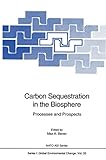Carbon sequestration in the biosphere: processes and prospects [Libro electrónico] / editor: Max A. Beran
Beran, Max A [editor].
Tipo de material: Libro
en línea Series Editor: New York, New York, United States: Springer, c1995Descripción: xiv, 305 páginas : ilustraciones ; 24 centímetros.ISBN: 3540601902; 9783642799457 (Print); 9783642799433 (Online).Tema(s): Ciclo del carbono (Biogeoquímica)
Libro
en línea Series Editor: New York, New York, United States: Springer, c1995Descripción: xiv, 305 páginas : ilustraciones ; 24 centímetros.ISBN: 3540601902; 9783642799457 (Print); 9783642799433 (Online).Tema(s): Ciclo del carbono (Biogeoquímica)| Tipo de ítem | Biblioteca actual | Colección | Signatura | Estado | Fecha de vencimiento | Código de barras |
|---|---|---|---|---|---|---|
| Libros | Biblioteca Electrónica Recursos en línea (RE) | Acervo General | Recurso digital | ECO400562413423 |
Incluye bibliografía
Chapter 1. Keynote papers.. 1. Global carbon cycle and carbon sequestration.. 2. Carbon sequestration by marine biota.. 3. Carbon sequestration in wetland ecosystems: a case study.. 4. Carbon sequestration in marine systems.. 5. Mechanisms and controls of carbon flux: carbon fixation and allocation.. 6. The role of decomposition in c sequestration in ecosystems.. 7. Feedback mechanisms between degradation and primary production in the marine pelagic environment.. 8. Systems models of terrestrial carbon cycling.. 9. Can the terrestrial biosphere be managed to conserve and sequester carbon?.. Chapter 2. Working group reports mechanisms.. 10. Carbon fixation and allocation.. 11. Carbon mineralisation.. 12. Feedbacks and modelling systems.. Chapter 3. Working group reports management.. 13. In marine ecosystems.. 14. In wetland ecosystems.. 15. In terrestrial ecosystems.. Chapter 4. Posters.. 16. The economics of forestry options to offset the greenhouse effect.. 17. Agriculture management effects on soil carbon sequestration in eastern Canada.. 18. Aquatic calcification as a source of carbon dioxide.. 19. Management-induced changes in the quantity and composition of organic matter in soils of eastern Canada.. 20. Co2 emissions from animal husbandry: a case study for Hungary based on production data for 1980.. 21. Nutrient cycling and coastal pollution in Izmir bay, turkey.. Bibliography
Disponible para usuarios de ECOSUR con su clave de acceso
Anthropogenic release of carbon dioxide into the atmosphere has been recognized as the primary agent in global climate change. The volume discusses the possibilities for limiting that increase by the long-term storage of carbon in soils, vegetation, wetlands and oceans. Each of these storage media is analysed in detail to elucidate those processes responsible for the uptake and release of carbon. Several chapters address the practical prospects for deliberate interventions aimed at adjusting the balance in favour of uptake over release, i.e. sequestration, while having regard to simultaneous changes in the various environments. eng
Disponible en línea
Disponible en formato PDF
Subscripción a ELSEVIER 26 de diciembre del 2013
